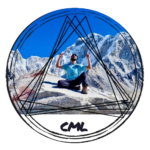Arriving in Banyuwangi
As you might remembered, I had just arrived at Gilimanuk harbour, got off the bus and went upstairs to take a look at the strip of sea separating Bali from Java. It wasn’t easy to find out the cheap and easy route from Bali to Java, or, in my case, from Kuta to Banyuwangi, the town next to Kawah Ijen. But, after an evening of research, I managed to get the right one. The time spent on the research and the trip was nothing compared to my excitement as I was about to start chasing the blue fire at Kawah Ijen.
After 30 minutes or so, the ferry made it to Java. We got back onto the bus and started driving to Banyuwangi. The ride took one hour and, as we were approaching the city, the bus driver told me to get ready. He pulled over and I jumped off the bus (literally). I checked my phone and realised I was kind of far away from the hostel. I tried to use Grab but found out it wasn’t working there. Thus, I used Go-Jek and, after a short ride and 8 K, I made it to Mango Tree Guesthouse.
The owner and the people working there were very nice. They welcomed me kindly and showed me my room. For the first time during my trip in Indonesia I had a room to myself. I paid 65 K with breakfast included. Not bad huh?
I took a shower and walked outside, looking for a place to eat. The hostel had a good location and, after a couple of minutes, I made it to what it looked like a main road. It was around 17:00 so there weren’t many places open for lunch. Nonetheless, I found a very good one: D’Sambal Barong. They didn’t speak any English, but my Bahasa was already good enough to distinguish between ayam (chicken), telur (egg) and other ingredients. I ordered Nasi Goreng with telur plus a drink. It was delicious. When I asked for the bill… I couldn’t believe it. I thought Bali was cheap. But, Java was just at another level, specially when it came to food. I paid 13 K for a full meal and a drink. Crazy, isn’t?
How to hike to Kawah Ijen?
After the tasty and cheap meal I walked back to my hostel. It wasn’t very busy, but the few people I met where there for the same reason: hiking to Kawah Ijen. Now, as far as I’m concerned, there are two ways to make it to Kawah Ijen. I’ll try to explain them both so you can pick your favourite 🙂
1 . On your own:
I normally try to do everything on my own, as long as it is “possible”. In this case, it was indeed possible, but after pondering the pros and cons, I decided to join an organized group. If you take a look at Google Maps or Maps.me, you shouldn’t have problems getting a route from your hostel to the base camp of Kawah Ijen. It was my case back when I was considering my options.
Once at the base camp, the hike to the crater of Kawah Ijen shouldn’t take more than 2 hours. That being said, the drive from Banyuwangi to Kawah Ijen’s base camp was kind of long (around 1,5 hours). I would have to be driving in the darkness and I didn’t know how good the road was. I also felt like I would like to be together with some other people experiencing the whole Kawah Ijen hike. Thus, in the end, I decided to pay for an organized trip.
2 . With an organized trip:
I mistook “Danu’s Homestay” for “Didu’s Homestay”. A couple of days before arriving to Banyuwangi, I sent some messages to the person organizing the hike to Kawah Ijen. Once in Banyuwangi, I went to the Homestay to confirm the trip and pay for it. I met a funny and kind old lady who seemed confused to see me. That was already a hint, but, until I met the owner, I didn’t realised about my confusion. I had been talking to the owner of Didu’s Homestay, but I was now at Danu’s Homestay, lol.
It turned out to be a good decision, at least price-wise. Didu’s Homestay was charging 350 K while Danu’s Homestay charged me 275 K. That final priced included the transport to and from Kawah Ijen’s base camp, a local guide, a mask, a flashlight and a small bottle of water. Oh, and it also included the entrance fee (100 K during weekdays and 150 during weekends). That’s the price for us, tourists. For locals though it is 5 K and 7,5 K. The 275 K I paid also included two stops on the way back. One to see a coffee plantation and another one to see a waterfall. Thus, I felt like 275 K for the whole thing was a great deal, what do you think? 🙂
About Kawah Ijen
I was laying on the bed of the hostel, taking a break and getting ready for what was about to come. I’ll try to give you some info on Kawah Ijen, so you can picture the place where I was going to be hiking to.
Kawah Ijen is an active volcano located on East Java, between Banyuwangi Regency and Bondowoso Regency. It is part of the Ijen volcano complex, consisting of a small group of stratovolcanoes within the large 20-km-wide Ijen caldera. The Gunung Merapi (2800 masl) is the highest point of the complex. “api” means fire, and, during my time in Java, I would get to hear the name “Merapi” again. West of Gunung Merapi we find Kawah Ijen (2386 masl), one of the most astonishing and unusual volcanoes in the world. The crater is not empty, but it is home to the world’s largest (1-km-wide) acide lake. Due to the extreme acidity and a high concentration of dissolved metals, the lake is filled with stunning turquoise water.

By the lake, a continuous stream of sulfur-laden gases blasts from fumaroles (hot vents). These gases (as you might imagine) are kind of hot. They travel underground in the absence of oxygen. When they emerge from a vent, depending on its temperature, two different events can happen. If they are hot enough, as they come in contact with the oxygen, they ignite and burn with an electric blue fire. If they are not that hot, they condense, fall to the ground as liquid (“flow of blue lava”) and eventually solidify, after having travelled a short distance. The second event is the responsible of the renewable deposit of sulfur, mined by locals.

The miners who work here are subject to one of the most dangerous, extenuating and worst paid jobs in the world. They walk down from the top of the crater to the lake. The path is steep and narrow. Using steel bars they break the solid sulfur into pieces. They load these pieces into reed baskets and start the ascend back to the top of the crater. From there, they take the sulfur to the refinery. They can carry loads of up to 90 Kg and they try to make two trips per day. They are paid a shameful amount of money: around 680 IDR per kilogramo. If you do the math, if they are lucky, after a terrible day of work, they can make up to 7-8 euros.
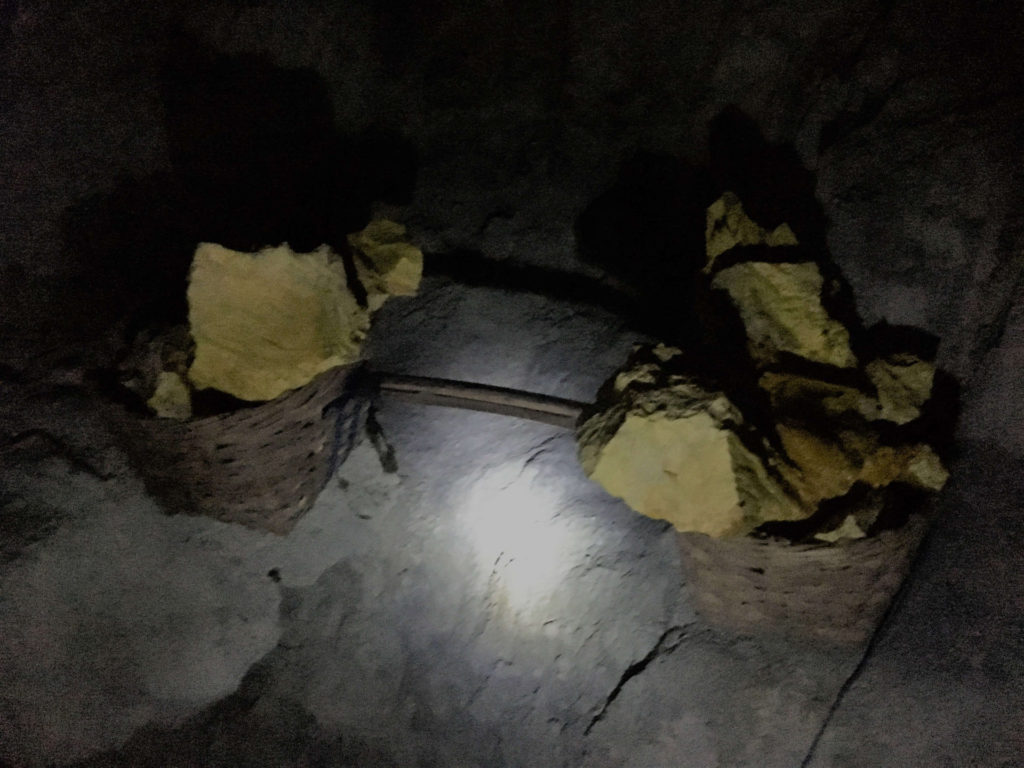
It’s not just about the load they carry every day, which is insane. But about the conditions they are exposed to. Inhaling those gases for a brief amount of time makes your eyes burn and cry. You feel suffocated. You start coughing and you have problems breathing. That’s what happens when you are exposed to that for a few seconds. Imagine doing that every day during hours. If that’s not slavery I don’t know what’s the right word to use. They handcraft figures of sulfur that they sell for really cheap prices. So, if you go to check Kawah Ijen out, please, buy some from them, or just help them out with some money. That won’t change drastically their lives, but at least it can help them raising their kids. To really help them, the Government of Indonesia should be the first one steeping in.
Nightly hike to Kawah Ijen
After having rested for a bit and prepared all my stuff for the nightly hike, I went outside to find a place to have dinner. Unlike during the afternoon, I found plenty of locals open. I ended up at Warung Lare Osing. The food was once again really good and extremely cheap. I paid 15 K for a full meal and a drink. Crazy! The people working there didn’t speak much English, but you shouldn’t have problems ordering what you want. They are super kind and attentive.
I wandered around for a bit and went back to the hostel. I laid down on my bed but didn’t catch much sleep and I ended up waking up before the alarm went off. It was 00:00. I was picked up at my hostel and brought to Danu’s Homestay. There were some people there, waiting for the nightly hike. We introduced each other and jumped in the 4 WD car.
We were 6 people in total: two guys from France, one girl from France, one girl from Sweden, a guy from Livia and myself. The two guys from France were firemen. They were there to try to extinguish the blue fire. Just kidding lol. They were on holidays. The girl from France was doing something similar to what I was doing but for a longer period. She was travelling for half a year! And the girl from Sweden and the guy from Livia were also travelling for a shorter period.
The road to the base camp of Kawah Ijen felt good enough. You have to take into account though that it was dark, I wasn’t driving and the car was a 4 WD. All in all, I guess it can’t be worse than the ones in Nusa Penida. It took us around one hour and a half to make it to the base camp. Once there, we got off to meet our guide. We also met the new temperature: it was chill. It was completely dark, except for the flashlight of the hikers and the light coming from some shops, were you can buy food and drinks. There were also some people selling flashlights and masks. After a brief talk with our guide, we got ready to start the hike. Before though, we double-checked we were carrying all the stuff needed for our nightly hike to Kawah Ijen.
What do you need to hike to Kawah Ijen at night?
- Water
- Mask
- Flashlight
- Warm clothes like a hoodie and a pair of long pants. You might not need them during the steepest part of the hike, but you will need them earlier and later on.
- Some food. Remember you are going to spend around 8 to 10 hours outside of your hostel. You might want to bring it with you or buy it at the base camp.
- An average level of fitness and willpower. It is not like if you were going to climb the Everest but, some parts, specially at the beginning, are kind of steep.
- A good camera. I couldn’t get good photos from the blue fire with my phone.
We started the hike at around 02:00. That time is just perfect if you want to see the blue fire and the sunrise later on. If you don’t care much about the blue fire, you can go later, to avoid the crowd. You can even go during the day, but, like that, it will be almost impossible to see the blue fire.
The beginning of the hike was kind of easy. The way was not very steep and it wasn’t crowded. We were walking under a beautiful starry sky. It was an amazing feeling, being there, in the darkness, with the only light being the one of our flashlight. I was there with people I had just met but with whom I shared a common goal: chasing the blue fire at Kawah Ijen, one of the most incredible volcanoes in the world.
After the first 15 minutes or so the path started to become steeper. It wasn’t the end of the world, but you could feel your legs started to work harder. You might also feel you start sweating. We started to see some miners and tourists. We also run into a couple of hotels and Warungs.
Once we had conquered the first 45 minutes, we started to feel a flattening on the path. We had left the hardest part behind and the next 45 minutes were kind of easy. The landscape was still the same: some miners and tourists showing up now and then in the darkness. Little by little, as we approached the top of the crater, we started to feel a change in the air we breathed. We were getting closer to the sulfur source and we were told to put our masks on.

After 1,5 hours we made it to the top of the crater of Kawah Ijen. Then we saw this:
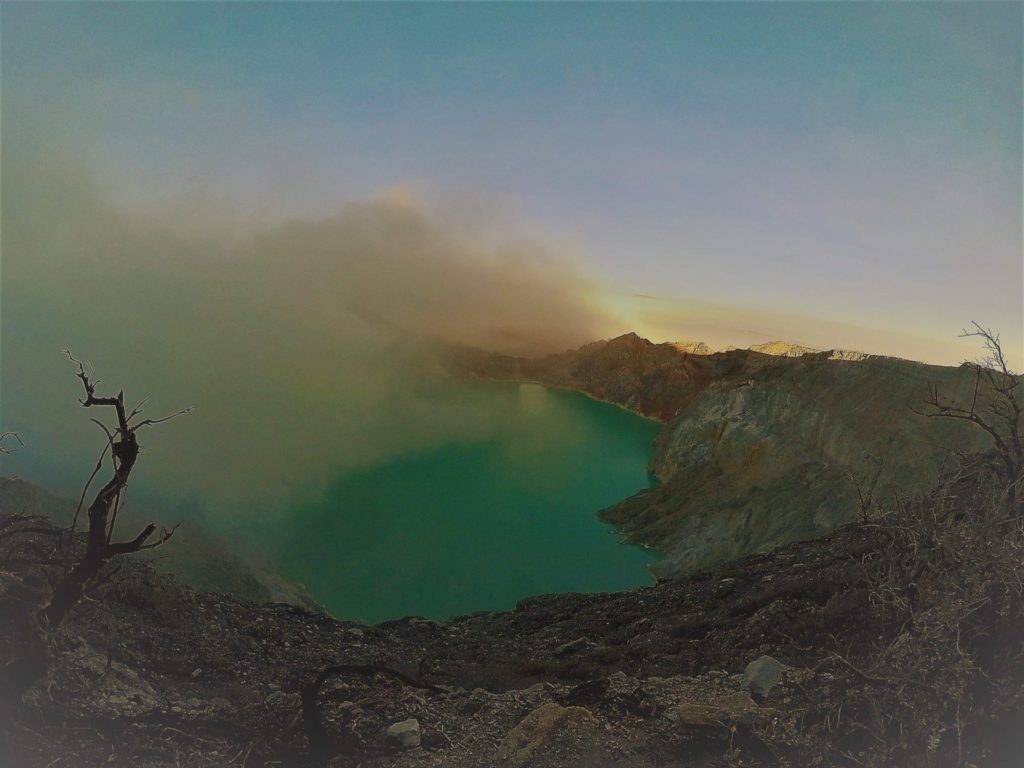
Chasing the blue fire at Kawah Ijen
We had just made it to the top of the crater and we were about to start our way down to the lake. If you want to chase the blue fire at Kawah Ijen, you need to go down to the lake. The air you breath there is not the healthiest in the world, but it is not like you are going to spend years there (like the poor miners). We saw some people who didn’t want to make it to the lake and stayed there, waiting for the sunrise. There is no right or wrong choice here, it depends on how you feel. For me, the main reason to go on the nightly hike was trying to see the blue fire, so, I decided to join my group and start the descent to the biggest acid lake in the world.
The path down is rocky, steep and narrow. During most of the way there is room for just one person. So, if you have someone slower in front of you, relax, take it easy and walk slowly. When you see a miner approaching, please, move out of his way. Try to get as close as possible to the edge so he can pass. I don’t care if you are about to get the best picture in the world. Imagine what it feels carrying a weight of 90 kilos on your shoulders and seeing someone in front of you who is not moving.
It took us a while to get down to the lake, mostly due to the width of the path. The way down was not difficult or extenuating, but you needed to watch out. The feeling of suffocation was growing. We run into some miners with the load of sulfur in the baskets over their shoulders. It was speechless. Working under these conditions should be forbidden.
We made it to the left side of the lake, from where we started to feel the full power of the gases coming out of the pipes. My eyes started burning. I started coughing and the breathing became harder and harder. All of that regardless of having my mask on.
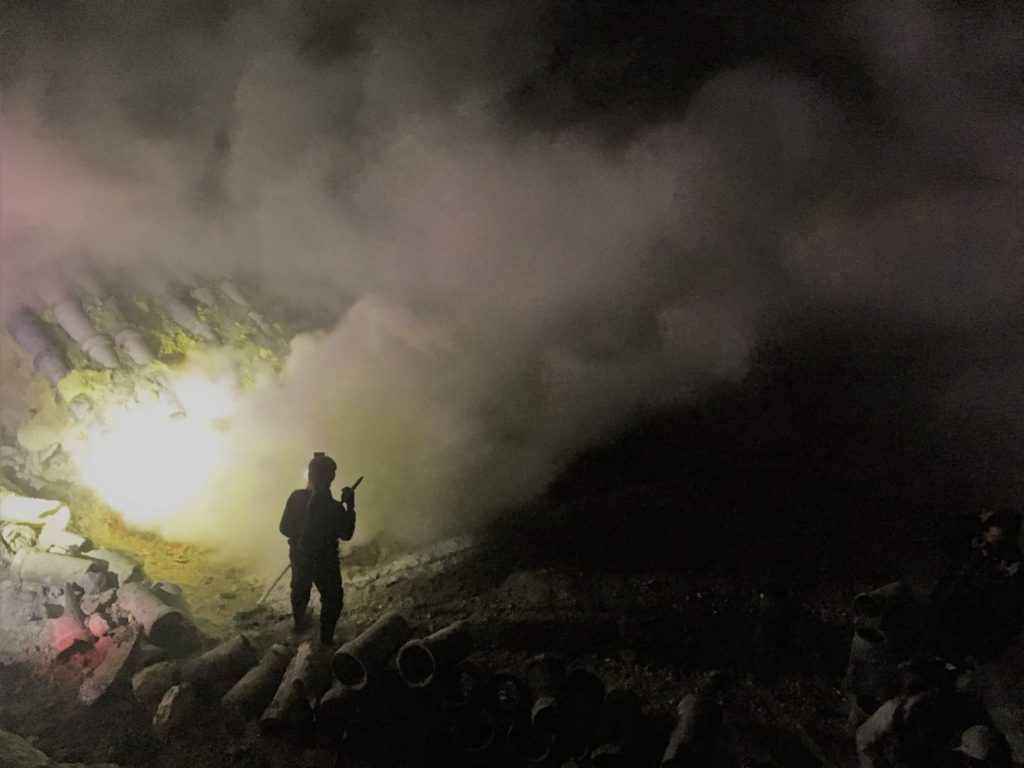
Regardless of the tough time I was going through, I tried to make it as close as possible to the vents. There were some people a little further away with the flashes of their phones on. That didn’t help trying to see the blue fire. To see it, it needs to be completely dark. We spread the word and eventually they turned their flashes off. Then, the magic happened.
It wasn’t like you would see a storm of blue fire in front of you. For that to happen, an explosion needs to be in place. The flames were very tiny and subtle and you needed to be very close to the vents to really distinguish them. At the same time, the feeling of burning eyes and a troublesome breathing made it really hard to stay there for longer. All in all, I don’t regret having approached the vents and I was happy with what I saw. But, just to set your expectations right, don’t expect to see a blue version of the Northern Lights.
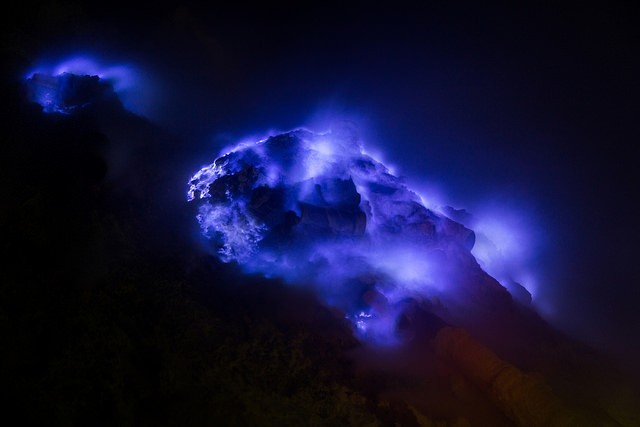
We backed off to a place far away from the vents. We gathered our group and made sure everyone was safe and sound. After taking a break, I went with some of my colleagues to the rim of the lake. We were told we could touch the water and so we did and… I still have two hands with ten functional fingers. The water was kind of hot. We didn’t see much because it was still dark. That though was going to change pretty soon.
Sunrise by Kawah Ijen
We started the ascent back to the top of the crater. After having seen glimpses of blue fire and having touched the water from the biggest acid lake in the world, we wanted to see the sunrise. The way back up was kind of slow again. Little by little, step by step, as we could start to feel the unmistakable hint of a new day coming, we made it back to the top of the crater.
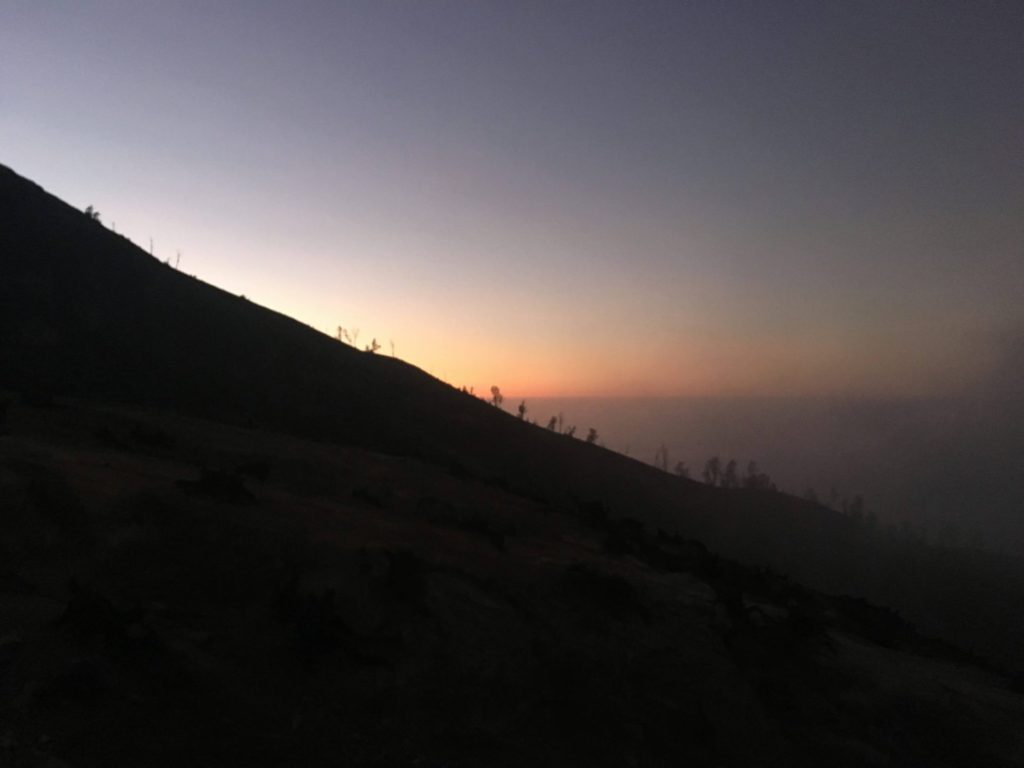
We looked down to the crater and we saw nothing but smoke. We used the same patience we had used following the path down to the lake and back and, eventually, we started to distinguish the lake whose water we had touched a short time ago. It looked something like this:

We had spent almost a whole night hiking. We had walked under a beautiful starry sky. We had been chasing the blue fire at Kawah Ijen and we managed to see some glimpses. We had experienced the suffocation of breathing sulfur gases. We had touched the water of the biggest acid lake in the world. We had seen human beings doing what should be categorized as slavery jobs. We were on the top of one of the most incredible volcanoes in the world and the sun was rising. We felt so fulfilled with the whole experience that we couldn’t do anything other than spinning. What would have you done?

We started to see the sign of a new day as well as people gathering around. But we couldn’t really spot the sun from there. It was then that our guide told us that in order to see the sunrise in front of the crater lake, we needed to be in the European Summer. Either that or going to Gunung Merapi. Regardless, we went for a walk around. And, even if we didn’t get to see the sun, we still saw amazing landscapes like this one:
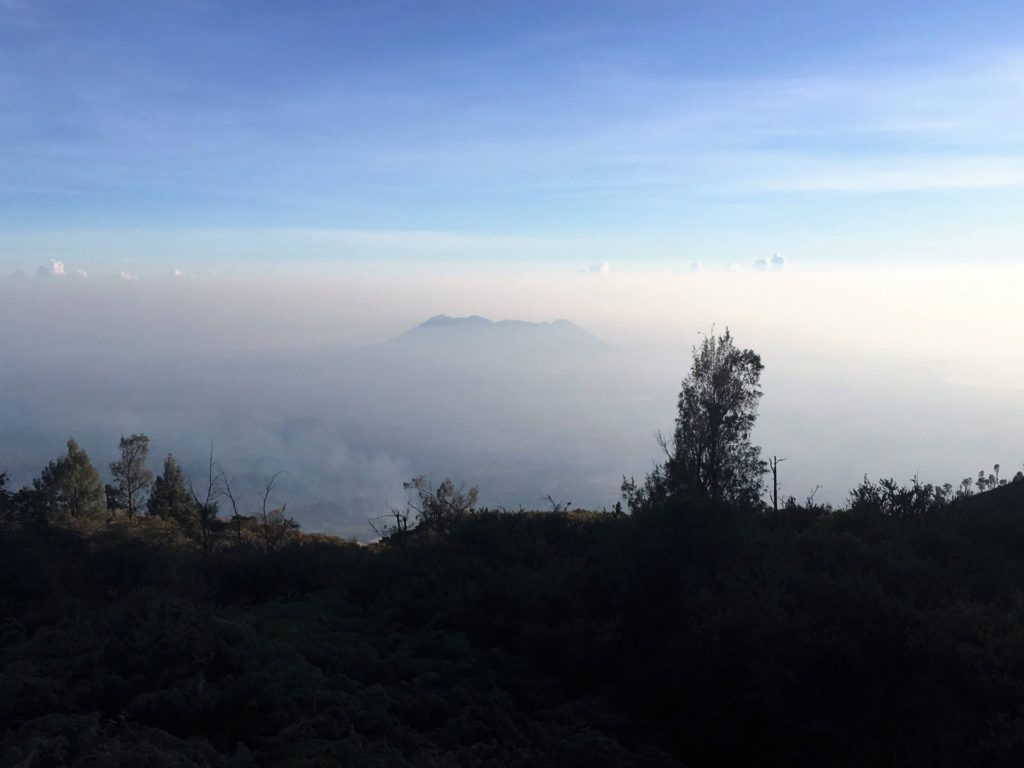
Stopping on the way back to Banyuwangi
After a while, we decided to start the descend back to the base camp. It was kind of funny. Some hours ago, we were walking through a path we couldn’t pretty much see. Now, with the light of the new day, we could clearly see where we had been steeping on.
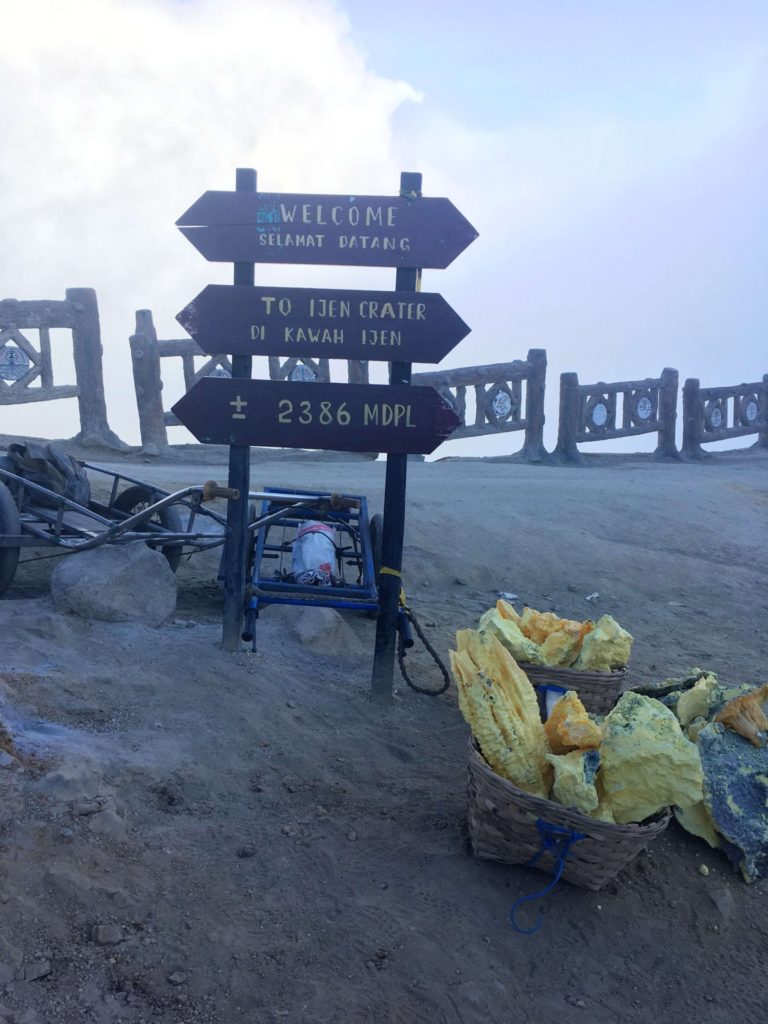
The descend was kind of easy, except for some slippery parts. After 45 minutes or so we were back at the base camp. We thanked our guide, gave him some tip and got ready to drive back to Banyuwangi. As soon as we got into the car we kind of fell asleep. I had pretty much forgotten about the two stops we had on the way back to Banyuwangi.
The driver woke us up when we were in front of the first stop: a coffee plantation. We came out of the car and walked around the coffee trees for a while. Up till then I had never seen a coffee tree in my life. They were nice and so the smell they released. The only problem is that we were too tired to really appreciate it. Because of that, we didn’t stay for too long. And, also because of that, I didn’t really take any pictures. Sorry about that!
Back in the car, we drove to the last and final stop before Banyuwangi: a waterfall. We had to take some steps downwards to make it to the waterfall. As we approached it, we saw a nice bamboo bridge. It look similar to this:
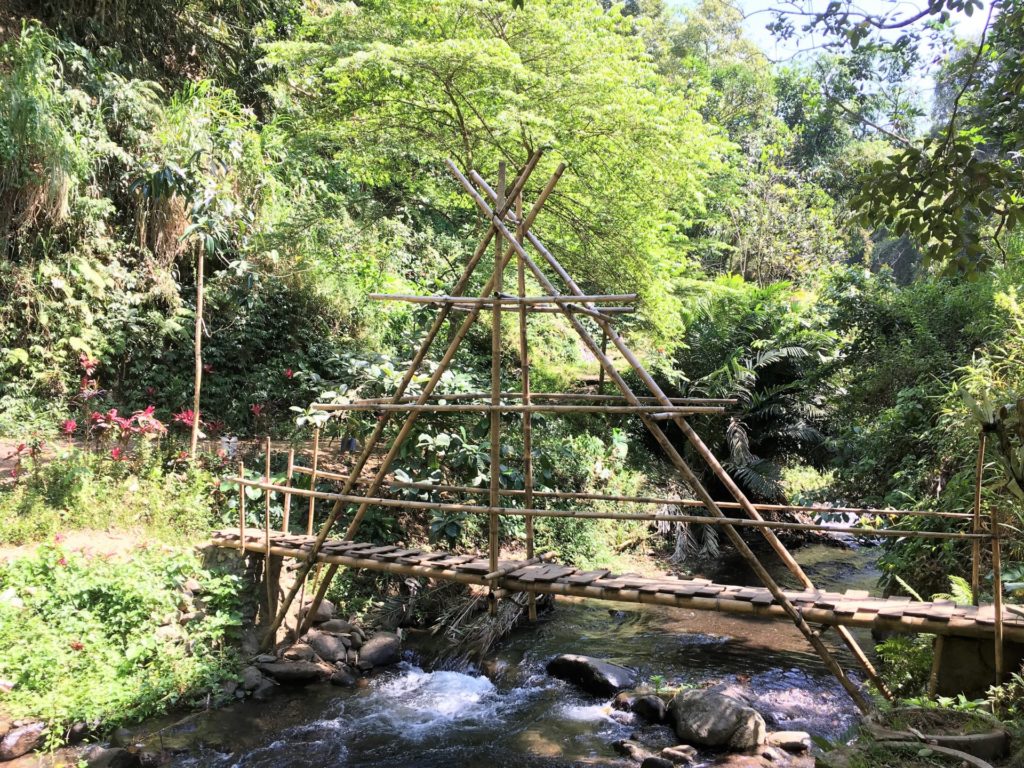
The waterfall was alright. I guess the reason why I didn’t feel more impressed about it was because I was used to see pretty cool waterfalls. And why was that? Well, because I chased waterfalls now and then during my time in Cairns 🙂
So long Banyuwangi!
After chilling around the waterfall for a while, we took the steps upwards and got back to the car. After a while we finally made it to Banyuwangi. I said good bye to my companions for the night and went back to my Mango Tree Guesthouse. It was around 10:00. Just like that, ten hours had passed since I had came out of the hostel’s door. During those ten hours, I had experienced plenty of unbelievable things. Chasing the blue fire at Kawah Ijen was the key reason for my trip to Banyuwangi. I had succeeded and, on the way, I had seen and experienced some other breathtaking stuff. I feel asleep while thinking about it and… two hours later, I woke up because it was check-out time. Yeah!
I told the owner of the hostel I wanted to make it to the train station. The reason? I hadn’t had enough with Kawah Ijen and I wanted to check yet another impressive volcano: Mount Bromo. To that extend, I needed to take a train to Probolinggo. He asked one of the guys working there to give me a ride to a shop where I could buy the train ticket. We made it there but we were told we needed to go to the train station. Apparently, for some other destinations you can buy the tickets in advance at the shop, but it wasn’t the case with Probolinggo.
We went back to the hostel and, after thanking the owner for everything (he had been really kind with me), I was taken to Banyuwangi’s train station. I paid my driver 9 K and I started to walk towards the entrance of the terminal. The train station was kind of small. I heard a couple of girls speaking Spanish. I approached them and asked them about the tickets to Probolinggo. They told me they had just bought them and didn’t think there were any more left.
Regardless, I decided to approach the counter. They had sold pretty much all the tickets, but they had a couple left. Yeah! I paid 29 K for the train ticket. That’s less than 2 euros. And that was the price for a train that had aircon and would take around 4 hours to Probolinggo. How crazy is that? I went back to the place where I had met the two girls and found out they were gone. Instead, I spoke to a girl from Israel who had just met them. She told me the girls had gone outside to find something to it. They came back after a while, right on time.
One of them was from the Basque Country and her name was Maider. The other one was from Chile and her name was Constanza. We started to walk to our coach and it was then when we found out we were sitting together. I didn’t know it just yet but I would be spending more than a few hours with them on the train. You want to find out more? Check out my next post! 🙂

